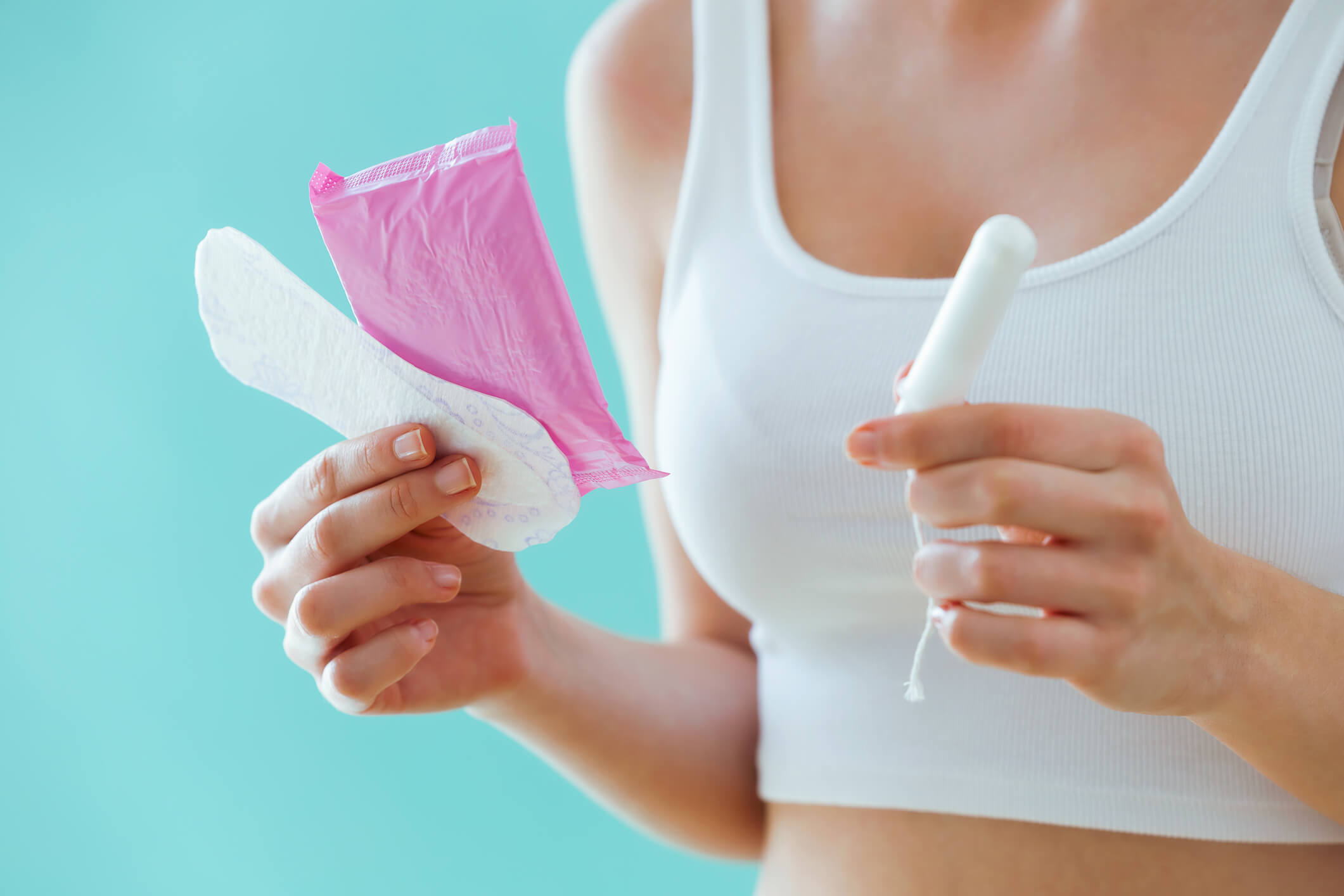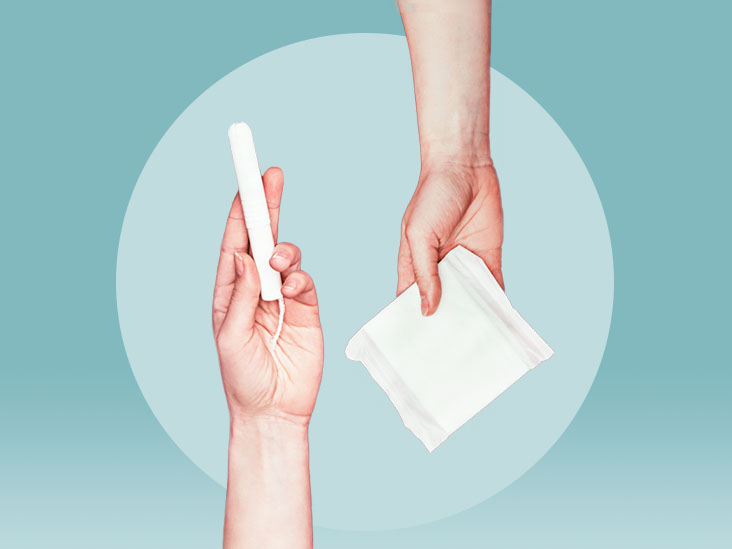Tampons vs. Pads: The Ultimate Showdown

Ahhh, the age-old dilemma of tampons vs. pads. If you’re prone to waking up to sheets that resemble a crime scene, then the biggest pad with wings is probably at the top of the list. But when the sticky backing pulls at your pubes, it’s back to tampons again.
Plus, today you can find reusable cups, washable pads, and period-proof panties, among other things.
Here’s a look at all the pros and cons of the most popular menstrual products.
Tampons still reign supreme
These little cotton cylindrical pads that fit inside your vagina are currently the most popular menstrual product. They come in different absorbencies to accommodate light to heavy periods.

Pros
You don’t need to be a tampon user to see the obvious pros of tampons. Their size makes them small enough to fit in a tiny pocket or in the palm of your hand, so they’re convenient and discreet (not that menstruation is anything to be ashamed of).
Other tampon pros:
- You can swim in them.
- You don’t have to worry about them being visible (minus the whole issue of tampon strings in swimsuit).
- You can’t feel them when they’re in properly.
Cons
The biggest downside to wearing tampons is the risk of toxic shock syndrome (TTS). It’s a rare but life-threatening complication of certain types of bacterial infections.
It used to be primarily associated with using super-absorbent tampons. Manufacturers made changes to these products in the 1980s, and at least one brand of super-absorbent tampons was taken off the market.
Incidents of TTS have dropped since then and are currently estimated to affect 0.8 to 3.4 per 100,000Trusted Source people in the United States. That includes non-menstrual cases, too.
To reduce your risk of TTS:
- Use the lowest absorbency tampon you can.
- Change your tampon frequently.
- Alternate between tampons and pads when your flow is light.
- Avoid wearing a single tampon all night.
Other cons:
- Inserting them can be uncomfortable, especially when trying a new one.
- Finding the right size and type for your flow takes some trial and error (i.e., there will be accidents).
- They have a big environmental impact, with millions of tampons and their packaging end up in U.S. landfills every year.
- They can sometimes irritate and dry out your vagina, making it itchy and uncomfortable.
Opt for tampons if you:
- are working out or otherwise on the move
- are heading to the beach or a pool party
- need something you can throw in your pocket
Pads still have their place, too
Pads are rectangles of absorbent materials that stick to the inside of your underwear. They’ve come a long way since the bulky, diaper-esque pads you still hear horror stories about.
Pros
People with heavy periods and anyone who’s ever woken up to a mess swears by them. They’re also great if your new to the world of menstruation or have a hard time wearing tampons.
Other pros of pads include:
- They come in lots of options to accommodate changes in your flow and activities.
- They carry almost no risk of TTS.
- You can wear them overnight.
- You don’t need to insert anything.
Cons
Even though pads are thinner than ever, they’re more likely to be visible under certain types of clothing. Again, there’s nothing to hide here, but you also don’t want to feel self-conscious all day.
Other cons:
- You can’t swim in them. (Take it from someone who’s endured the horror of watching her pad float on by while swimming with friends.)
- Like tampons, there’s the environmental factor, though reusable options are now available (more on these later).
- They can shift out of place and wrinkle up in the center when you’re moving.
- They aren’t very discreet thanks to the very obvious sound of pulling them off your underwear.
- You can’t wear them in thongs or G-strings, if that’s your thing.
Opt for pads if you:
- value waking up in clean sheets
- find tampons hard to insert or uncomfortable to wear
- wear tampons but want some back-up protection against leaks
But cups are shaking things up
Menstrual cups are flexible cups made of silicone or rubber that you wear inside your vagina to catch menstrual blood. It’s important to note that not all cups are reusable, so be sure to read the label if you prefer a reusable cup.
Pros
Like other menstrual products, cups have their pros and cons, but the pros are pretty impressive.
For starters, most cups are reusable: just rinse and wear them again! Being reusable means you save a lot of money. It also means less landfill waste and fewer trees being cut down to make paper-based options and packaging.
Other pros:
- They can be worn for up to 12 hours at a time.
- You can buy them in a variety of colors, sizes, and styles.
- You can wear them during sex.
- You can wear them with anything.
- You can swim in them.
- They don’t disturb your vaginal pH.
- You can’t feel them once they’re in properly.
- They generally result in less period smell (yeah, you know what that is).
Cons
That’s a lot of pros in the cup’s favor, but it’s not all rainbows and unicorns.
Some cons:
- Things can get messy because you have to use your fingers to fish it out of your vagina, then dump and rinse it.
- If your periods are heavy, the cup may runneth over long before the 12 hours.
- You may have trouble with fitting the cup if you have fibroids.
- Insertion can be tricky for some.
- If you wear an IUD the cup can pull on the string and dislodge it.
- You’ll need to give it a thorough wash after each cycle
- Though cheaper in the long term, the initial cost is roughly $25 to $40, depending on the brand
- Some cups contain latex, so be sure to read the label if you have a latex allergy.
- TTS from menstrual cups is possible when not used as directed
Opt for a menstrual cup if you:
- have a little extra cash on hand
- want to have sex during your period without the bleeding
- are looking to reduce the environmental footprint of your cycle
- want a set-it-and-forget-it approach
Oh, did you think that was all?
Yes, there are still more options.
Padded underwear
Period panties, menstrual underwear — whatever you call them, they’re a thing. These absorbent panties can hold as much as a couple of pads or tampons worth of blood, depending which ones you buy.
Pros
- They’re reusable, so they’re good for your wallet and the planet in the long run.
- They can accommodate a light to medium flow.
- You can buy period panties in different styles and colors, including generic briefs because not everyone wants lace and frills.
- You can wear them as extra leak protection with pads and tampons at night or on heavy days.
Cons
- The upfront cost is more than regular underwear.
- They’re not recommended for heavy flows.
- Sizes vary between brands so getting the right fit may take some (costly) trial and error.
- You have to wash them, which can be an issue if you need to change them on the go.
Reusable cloth pads
Reusable cloth pads are washable pads that work like regular disposable pads, only you don’t throw them out. Plus, they don’t make the whooshy diaper sound that disposable pads often make.
Pros
- They’re more cost-effective in the long run.
- They create less waste in landfills than disposable products.
- They’re available to buy in different sizes and absorbencies.
- They’re more flexible and less bulky than most pads.
- They’re more breathable than regular pads.
Cons
- The initial investment is a bit high.
- Their two-part design makes them less convenient for changing on the fly.
- You have to wash them, which can be messy, especially when you’re out and about.
- They can stain if you don’t rinse them right away.
Sponges
Sea sponge tampons are small sponges that are inserted into the vagina like a tampon.
If you’re going to try menstrual sponges, be sure you buy natural sea sponge, as some retailers sell synthetic sponges that are dyed and not necessarily safe. These are not the same sponges you wash your dishes or tub with!
Pros
- They’re reusable and some last up to 6 months with proper care and cleaning.
- They’re less likely to cause irritation than synthetic products.
- They cost less than some other reusable period products.
Cons
- They’re not sterile.
- You need to wet them before insertion.
- You need to rinse them every 3 hours.
- They must be thoroughly cleaned and dried before storing after your cycle.
- They can rip or pull apart when you’re removing them.
- You need to fish them out with your fingers, which can be quite messy.
- It’s possible to get TTS from sponges.
There’s always free bleeding, too
Free bleeding is having your period without wearing tampons, pads, or any other fluid barriers. Though people have been doing it for ages, the free bleeding movement has been receiving mainstream attention since Kiran Gandhi ran the London Marathon while free bleeding in 2015.
Free bleeding can be cause for concern, especially if you are going out into the public.
Dried blood is potentially infectious. Any surfaces coming into contact with blood need to be properly disinfected. The biggest risk is viruses, such as hepatitis, which can be transmitted through dried blood for several days.
If you’re going to give free bleeding a try, stained clothing and sheets are pretty much a given. Wearing period panties might be a good way to transition to free bleeding if you want to try it out but are hesitant. Carry disinfecting wipes with you in case blood gets on other surfaces.
Washing clothes and linens in cold water as soon as possible can help keep blood stains to a minimum. Investing in a waterproof mattress protector is also a good idea.
And finally, gender-neutral menstrual products are now a thing
Let’s face it: Most menstrual products are pretty female-centric, from their packaging and marketing to their incompatibility with boxers. If you menstruate but don’t identify as female, this can cause some pretty unpleasant feelings of dysphoria and general discomfort.
Though there’s still have a lot of work to do, more and more companies are taking a more inclusive approach in the design and marketing of their products.
Consider these products:
- the Boyshort and Training Shorts from Thinx
- LunaPads Boxer Brief
- OrganiCup menstrual cups, which are clear and come in unassuming packaging
Bottom line
The period game is about more than tampons vs. pads. You’ve got options, and at the end of the day it’s your period, your prerogative.
Consider your comfort, budget, convenience, and any other variables that matter to you when choosing your products. Try out different options to find what works best. Don’t be afraid to mix it up to accommodate the stages of your cycle.






